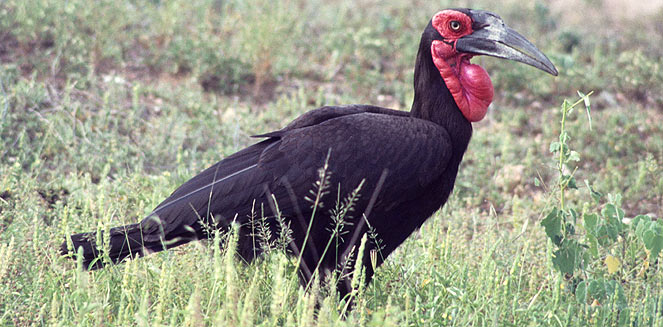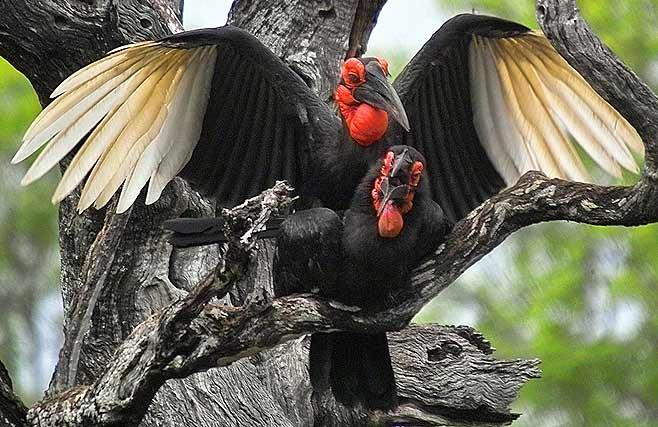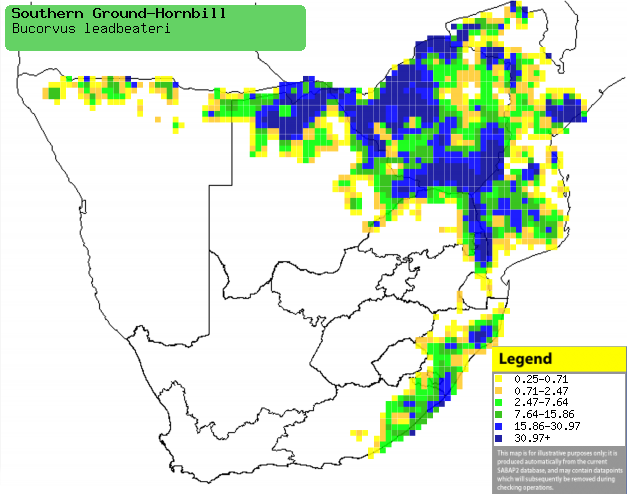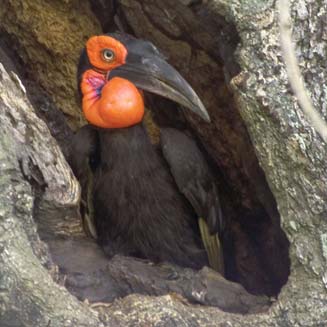Bucorvus leadbeateri (Southern
ground-Hornbill)
BromvoŽl [Afrikaans]; Intsingizi,
Intsikizi [Xhosa]; iNgududu, iNsingizi [Zulu]; Dendera [Shona]; Insingizi,
Ingududu [Swazi]; Nghututu [Tsonga]; Lehututu [Tswana]; Zuidelijke hoornraaf
Southern, African [Dutch]; Bucorve du Sud [French]; Hornrabe [German];
Calau-gigante [Portuguese]
Life
> Eukaryotes >
Opisthokonta
> Metazoa (animals) >
Bilateria >
Deuterostomia > Chordata >
Craniata > Vertebrata (vertebrates) > Gnathostomata (jawed
vertebrates) > Teleostomi (teleost fish) > Osteichthyes (bony fish) > Class:
Sarcopterygii (lobe-finned
fish) > Stegocephalia (terrestrial
vertebrates) > Tetrapoda
(four-legged vertebrates) > Reptiliomorpha > Amniota >
Reptilia (reptiles) >
Romeriida > Diapsida > Archosauromorpha > Archosauria >
Dinosauria
(dinosaurs) > Saurischia > Theropoda (bipedal predatory dinosaurs) >
Coelurosauria > Maniraptora > Aves
(birds) > Order: Bucerotiformes >
Family: Bucorvidae
 |
|
Southern ground-hornbill.
[photo H. Robertson, Iziko ©] |
 |
|
Southern ground-hornbills mating. [photo
Arno Meintjes ©] |
The Southern ground-hornbill occurs from Kenya and the DRC to
southern Africa, where it is widespread but never common, living in a wide range
of grassland, savanna woodland habitats. In South Africa, it is listed as
Vulnerable, with an estimated population of just 1500-2000. It eats a wide range
of food, especially animals, such as grasshoppers, frogs, mongooses and bird
nestlings. It is a monogamous, cooperative breeder, with a group consisting of a
dominant breeding pair and 0-9 helpers, who are usually either adult males, or
juveniles from previous breeding seasons. It lays 1-2 eggs, which hatch in the sequence laid, meaning that the one chick is 3-14
days older than the other chick. The younger chick is unable to compete for
food with its older sibling, and dies of starvation when it is 1, rarely 3-4
weeks old
Distribution and habitat
The Southern ground-hornbill occurs from Kenya and the DRC
to southern Africa, where it is widespread but fairly scarce in Botswana,
Zimbabwe, Mozambique, KwaZulu-Natal, Eastern Cape, Limpopo Province and
northern Namibia. It generally prefers grassland and savanna woodland habitats, ranging from montane grassland to extensive, tall
stands of Zambezi teak (Baikiaea plurijaga), Mopane (Colospermum mopane)
and Musasa (Brachystegia spiciformis) woodlands with sparse understorey.
|
 |
|
Distribution of Southern ground-hornbill in southern Africa,
based on statistical smoothing of the records from first SA Bird Atlas
Project (©
Animal Demography unit, University of
Cape Town; smoothing by Birgit Erni and Francesca Little). Colours range
from dark blue (most common) through to yellow (least common).
See here for the latest distribution
from the SABAP2. |
Food
Mainly eats animals, such as insects, frogs, mongooses and
bird nestlings.
It forages in groups, so that when one bird locates a prey item it can signal
the rest of the flock with a low bark. It often finds prey by digging,
especially in dung heaps, and it may snatch food from birds of prey. The following food items have been recorded in its diet:
- Animals
- Vertebrates
- reptiles
- mammals
- mongooses
- squirrels
- young hares
- birds
- amphibians
- Invertebrates
- carrion
- Plants (rarely)
Breeding
- Monogamous, cooperative breeder, with a group consisting of a dominant
breeding pair and 0-9 helpers, who are either adult males or juveniles from previous breeding seasons. The
group roosts in trees on rock faces, descending to the ground just before
dawn and foraging for a lot of the day. They often take a break at midday to play,
preen and pass around food to one another.
 |
|
|
Southern ground hornbill in nest cavity, South
Africa. [photo Arno Meintjes
©] |
|
- The nest is usually a cavity in a tree lined with
dry leaves, rarely nesting in cavities in rock faces or earthen
banks. The same site is used repeatedly over many breeding seasons.
- Egg-laying season begins with the first heavy summer rains, from
August-January, peaking from October-November.
- It lays 1-2, rarely 3 eggs 3-14 days apart, which are incubated
solely by the female for 37-43 days. The female only makes 3-4 brief
sorties out of the nest per day, so is largely reliant on the male and
helpers to provide food.
- The eggs hatch in the sequence laid, meaning that the one chick is 3-14
days older than the other chick. The younger chick is unable to compete for
food with its older sibling, and dies of starvation when it is about one
week old, occasionally surviving for a few more weeks.. The female leaves
the nest when the chick is about four weeks old,
after which the chick is mostly alone in the nest. The fledging leaves the nest
when it is approximately 86 days old, remaining with its parents for several
years.
Threats
Vulnerable in South Africa, were it has an estimated
population of just 1500-2000. Its South African distribution rang has decreased
hugely recently, due to persecution and habitat alteration. Its range is also
decreasing in areas of Swaziland, Zimbabwe, Botswana and other areas of
high human population density or extensive farming. However it is still
widespread in areas less populated by humans, such as north-eastern Botswana and
northern Zimbabwe, but it is still never common. It is generally revered by
African people, but it is also feared, leading to rare cases of it being
collected for "muti" for bringing rain. Current conservation measures include
hand-rearing of the otherwise redundant second born chicks, captive breeding and
reintroduction. For more information, visit the
Endangered wildlife trust's page on the Southern ground hornbill.
References
-
Hockey PAR, Dean WRJ and Ryan PG (eds) 2005. Roberts
- Birds of southern Africa, VIIth ed. The Trustees of the John Voelcker
Bird Book Fund, Cape Town.
|
